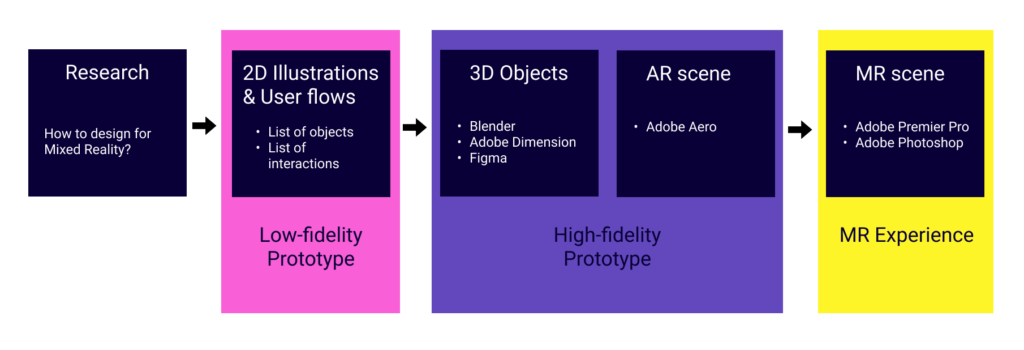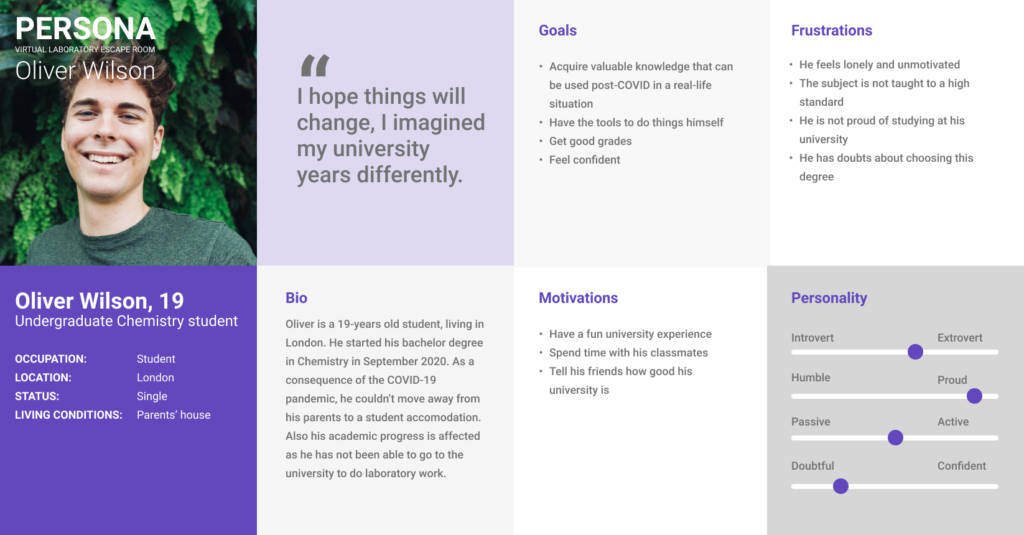Mixed Reality Escape Room
Timeline:
February 2021 – May 2021
Role:
UX Designer
Tools:
Blender, Adobe Dimension, Adobe Aero, Figma, Adobe Photoshop

Context
Students in higher education have been experiencing a significant change in education as a consequence of the COVID-19 pandemic. According to a survey conducted in January 2021, 37% felt dissatisfied or very dissatisfied with their academic experience and 73% said they did not attend any on-campus teaching in the last week.
There are numerous studies exploring blended teaching techniques, but none of these is focusing on whether students can benefit from these when learning laboratory-based modules entirely online.
/project aims
The product aims to provide a remote real-life learning experience for undergraduate Chemistry students.
The aims:
- Providing a gamified and high-standard online module delivery for undergraduate Chemistry students
- Improving student performance, satisfaction and engagement
Research
/survey results
A survey was sent out and filled by 44 students whose degree was heavily depended on laboratory workshops: 50% undergraduate, 39% postgraduate, 7% PhD, and 5% A-level students.
Covid-19 has affected the modules of nearly 70% of the participants and 43% said that these should not be taught online.
Types of change in module delivery:
- Cancellation of course-specific activities
- No interaction with others
- No or not enough time in the laboratories
- Low quality of teaching
Reasons why laboratory-based modules should not be taught remotely:
- No relation to real-life tasks
- No access to the tools=low assignment scores
- Missing physical tools to practice with
- Academic progress is limited
Ideate
/mixed reality
Mixed Reality (MR) combines Augmented and Virtual Reality, which creates a unique and realistic experience for the user. This product concept was designed by following the UX design principles of MR, and it could be used with the newest Microsoft Hololens 2 holographic device.
/escape room for gamification
To engage the students on a deeper level, the product uses the gamified elements of the famous escape room games. While a traditional escape room game includes solving tasks in a physical room, the MR escape room invites the students to recreate chemical reactions to escape the virtual laboratory.
/user journey
One day Oliver’s teacher emails the class and says that they will try a Mixed Reality application called the Escape Room. Oliver receives a Hololens 2 device from his university and joins their online lecture. The user journey shows Oliver’s emotional experience when using the application and highlights opportunities to improve the user flow.
Prototype
/process
The Covid-19 pandemic and the closure of my university meant that the product concept had to be designed without accessing a holographic device. To overcome this challenge, the Prototype stage included thorough research on how other mixed reality applications work and using different software to mimic the MR functionality.

/video
Test
/the acting technique
How do you test an MR product without accessing a holographic headset? I was inspired by one of Microsoft’s prototyping techniques, called acting.
I created physical models for all the interactable holograms and placed them on tables. The participants were asked to sit at the table, watch the onboarding video and use hand gestures to solve the tasks and escape the room.



/remote testing
The product was also tested remotely, using a clickable prototype created in Figma. The participants joined an online Zoom meeting and shared their screen with the Figma prototype. To mimic the product’s interactivity, the prototype took the participants to different YouTube videos that showed the recordings of the actual MR stages.
Reflection
This application was designed to provide an immersive and entertaining way of learning laboratory-based modules remotely for first-year undergraduate Chemistry students. The product idea is backed by thorough research, and it received positive feedback from the usability test participants. However, further testing is needed to identify additional usability issues.
/limitations
The high price of the holographic headsets impacts the feasibility of the project. If an institution does not have a budget for purchasing the devices, an alternative Augmented Reality Escape Room application could be designed. In this way, students could interact with the product on their smartphones. Additionally, it is a possibility that some of the students would not feel comfortable with using MR or AR technology. For them, a version built with Google Forms could be a solution.
/future steps
Overall, the Virtual Laboratory Escape Room application can improve the students’ academic experience in higher education during and after the Covid-19 pandemic, as remote learning is considered a trend in education.
The MVP could be further developed and tested in a Mixed Reality environment. In addition, other subjects could be included besides Chemistry, and the virtual space could be expanded from the students’ desks to their rooms or homes.








